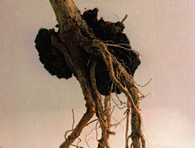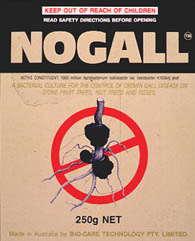
Nogall pest control
1989
pesticide using genetically altered bacterium
From the early 1900s, Australia has been a world leader in many areas of agricultural research. Biotechnology is opening up new industries in medicines and food production, and where there's industry there's innovation.
In the 1980s Australian scientists developed and patented a genetically engineered bacterium for use as a pesticide. Sold under the tradename Nogall, it was the world's first commercial release of a living, genetically engineered organism.
Crown gall disease attacks roses, raspberries, and nut and fruit trees. It is responsible for huge losses in crops around the world.
In the 1970s, scientist Allen Kerr discovered that a naturally occurring bacterium (called K84) produces an antibiotic against the crown gall bacterium. Unfortunately, K84 can transfer a copy of the gene for making the antibiotic to the crown gall bacterium, making it immune to the antibiotic.
Kerr had an idea for overcoming this problem. He used genetic engineering, snipping out the bit of K84?s DNA that allows it to transfer the antibiotic gene to the crown gall bacterium. The redesigned bacterium, sold as Nogall, effectively controls crown gall disease.
The research work performed by Allen Kerr won the first Australia Prize for Science in 1990. Nogall opened the way for agricultural techniques that give plants built-in resistance to pests and disease.
Who Did It?
Key Organisations
Bio-Care Technology Pty Limited : development & manufacture
Waite Agricultural Research Institute : research
Key People
Allen Kerr : developed new bacterium
Gary Bullard : director of Bio-Care
David Pulsford : director of Bio-Care
Further Reading
Making it: innovation and success in Australia's industries
R Renew
Powerhouse Publishing, Sydney, 1993, p 75.
Links
Biotechnology Australia
CSIRO Gene Technology in Australia
New Bioproducts.
Crown Gall Disease
Bio-Care
Technology
Innovations
ABC Radio Australia May 2001
Questions & Activities
Nogall pest control
Related Innovations
Nematodes for pest control
|












